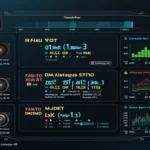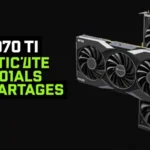Are you excited about the upcoming AMD RX 9070 graphics cards? With recent leaks hinting at their specifications and performance, it’s hard not to be! AMD is gearing up for a major reveal, and while some benchmarks may raise eyebrows, the potential of the RX 9070 models remains intriguing. Imagine diving into your favorite games with enhanced graphics and smoother gameplay—sounds appealing, right? As we await the official launch, let’s explore what these new GPUs might bring to the table.
Introduction to the AMD RX 9070
The AMD RX 9070 is making waves in the GPU market, and it’s easy to see why. With its upcoming launch, enthusiasts are buzzing about its potential performance and specifications. While some leaks suggest it may not quite hit the heights we expected, the RX 9070 still promises to be a solid contender in the graphics card arena. Let’s dive deeper into what we can expect from this exciting new release.
As AMD gears up for the launch of the RX 9070 GPUs, there’s a mix of excitement and skepticism from the community. The specs that have surfaced suggest both the RX 9070 XT and standard RX 9070 are equipped with impressive features, but how do they stack up against the competition? In this article, we’ll explore the details of these cards and what they might mean for gamers and creators alike.
Specifications Breakdown of the RX 9070
Let’s get into the nitty-gritty of the RX 9070’s specifications. The RX 9070 XT is rumored to boast 64 Compute Units, translating to a whopping 4,096 Stream Processors and a boost clock of 2970MHz. That’s a serious powerhouse for gaming and content creation! Meanwhile, the standard RX 9070 is slightly toned down with 56 Compute Units and a boost clock of 2520MHz, which still offers an impressive performance.
Power consumption is another critical factor to consider. The RX 9070 XT may require up to 304W, which is a bit heftier than some anticipated. In contrast, the standard RX 9070 is designed to be more manageable, with a power consumption of around 220W. This is great news for gamers who want a high-performance card without needing an extensive power setup.
These specifications are essential to understanding what each card can deliver. AMD seems to be setting these models up as serious competitors against Nvidia’s offerings, aiming to carve out a niche in the mid-range market. The real question is: will these specs translate into real-world performance that gamers crave?
Performance Expectations and Benchmarks
Benchmarking is where things get a little murky. Early leaks suggest the RX 9070 XT scored 179,178 in Geekbench OpenCL tests, which sounds promising. However, it’s important to approach these numbers with caution. Synthetic benchmarks can sometimes paint an overly optimistic picture of real-world performance, and that’s something we need to keep in mind.
Additionally, the RX 9070 XT is reportedly about 6% faster than the RX 7900 XT in OpenCL, yet slightly slower in Vulkan tests. This mixed performance raises eyebrows, especially given the expectations set by earlier rumors that suggested the RX 9070 XT would outperform Nvidia’s RTX 4080. So, what does this mean for potential buyers? It’s a wait-and-see game.
Don’t let the initial benchmark results discourage you just yet! Other tests, including those from 3DMark and real-world gaming scenarios, might showcase a different perspective. The RX 9070 could still surprise us with its capabilities once it hits the market. After all, benchmarks are just one piece of the puzzle.
Power Consumption and Efficiency
When it comes to power consumption, the RX 9070 series has some interesting figures. The RX 9070 XT’s 304W requirement is on the higher end, especially for those who want to build a gaming rig without breaking the bank on power supplies. Meanwhile, the standard RX 9070’s 220W rating makes it a more appealing option for gamers looking for efficiency.
Efficiency is key in today’s gaming landscape. With rising energy costs and environmental concerns, players are looking for GPUs that deliver great performance without excessive power draw. The RX 9070 series seems to strike a balance, offering gamers a choice between raw power and more manageable energy consumption.
Ultimately, the power consumption figures might influence your decision on which card to buy. If you’re looking for a high-performance GPU that won’t keep your electric bill sky-high, the RX 9070 could be the answer. As we approach the launch, keep an eye on how these power specs hold up in real-world scenarios.
Conclusion and Future Outlook
As we get closer to the official launch of the AMD RX 9070 GPUs, the excitement continues to build. While leaks provide a glimpse into what we can expect, it’s essential to treat this information with caution. The performance and power consumption figures hint at promising capabilities, but we’ll need to wait for real-world tests to draw any solid conclusions.
AMD’s strategy seems clear: carve out a competitive space in the mid-range market against Nvidia’s offerings. With the right pricing and marketing, the RX 9070 series could become a favorite among gamers and creators alike. It’s a thrilling time to be a tech enthusiast, and I can’t wait to see how the RX 9070 performs once it’s finally available.
In conclusion, the AMD RX 9070 GPUs represent an intriguing development in the graphics card landscape. As we prepare for the launch and await more detailed reviews, the community remains hopeful that these cards will deliver on their promises. Buckle up, folks; the GPU race is about to get even more exciting!
| Specification | RX 9070 XT | RX 9070 |
|---|---|---|
| Compute Units | 64 | 56 |
| Stream Processors | 4096 | 3584 |
| Boost Clock | 2970 MHz | 2520 MHz |
| Total Board Power (TBP) | 304W | 220W |
| OpenCL Benchmark Score | 179,178 | 140,842 |
| Vulkan Benchmark Score | 177,395 | 158,520 |
| Comparison to RX 7900 XT (OpenCL) | +6% faster | ~On par |
| Comparison to RX 7900 XT (Vulkan) | -4% slower | -6% slower than 7800 XT |
Frequently Asked Questions
What are the key specifications of AMD’s RX 9070 GPUs?
AMD’s RX 9070 GPUs come in two main variants: the RX 9070 XT and the standard RX 9070. The RX 9070 XT features 64 Compute Units, which translates to 4,096 Stream Processors, and a boost clock of 2970MHz, with a Total Board Power (TBP) requirement of 304W. On the other hand, the standard RX 9070 has 56 Compute Units (3,584 Stream Processors) and a boost clock of 2520MHz, drawing a more manageable 220W of power. This makes the RX 9070 a great option for those who want solid performance without overwhelming their power supply.
How do the RX 9070 GPUs perform in benchmarks compared to previous AMD models?
Benchmark results for the RX 9070 GPUs, particularly the RX 9070 XT, suggest a mixed performance outlook. In tests like Geekbench, the RX 9070 XT scored approximately 179,178 in OpenCL and 177,395 in Vulkan. These scores put it about 6% faster than the RX 7900 XT in OpenCL but slightly lagging by 4% in Vulkan. Meanwhile, the standard RX 9070 is comparable to the 7800 XT in OpenCL but falls behind by about 6% in Vulkan. These results indicate that while the RX 9070 series shows potential, it may not be the leap forward some were hoping for.
What can we expect from the upcoming AMD RX 9070 launch event?
With the official launch event for the RX 9070 GPUs just around the corner, excitement is building. AMD is expected to unveil the final specifications, pricing, and performance metrics. Previous leaks have generated some skepticism regarding the performance levels of these GPUs, especially compared to Nvidia’s offerings. However, AMD’s recent naming strategy suggests they are positioning the RX 9070 models to compete directly with Nvidia’s RTX 5070 series, which could mean competitive pricing and capable performance, regardless of what early benchmarks indicate.
Should gamers be concerned about the leaked performance of the RX 9070 GPUs?
While the leaked benchmarks might seem disappointing, it’s important to remember that these numbers come from synthetic tests, which aren’t always the best indicators of real-world gaming performance. Many experts suggest that the performance could improve in actual gaming scenarios. Additionally, AMD has a history of optimizing their drivers post-launch, which could further enhance performance. So, if you’re a gamer, it might be wise to hold off on judgment until we see the RX 9070s in action during actual gameplay.
What are the power consumption expectations for the RX 9070 GPUs?
Power consumption for the RX 9070 GPUs is a significant aspect to consider. The RX 9070 XT is expected to require around 304W, which is higher than some earlier rumors indicated, while the standard RX 9070 operates at a more comfortable 220W. This makes the RX 9070 a more accessible option for gamers with mid-range setups, ensuring that they won’t need to upgrade their power supplies just to accommodate these new GPUs. The power requirements suggest that AMD is balancing performance with power efficiency, catering to a broader audience.
Curious about AMD’s latest GPU, the RX 9070? Recent leaks hint at some intriguing specs—like the RX 9070 XT needing a hefty 304W of power but promising serious performance. While benchmark results suggest it may not be the powerhouse many hoped for, comparisons show it could still edge ahead of the RX 7900 XT in some areas. With an official launch just around the corner, excitement is building. Will the RX 9070 meet our high expectations? Only time will tell!
What do you think about these leaks? Are you excited or a bit let down? Drop your thoughts below and check out more juicy GPU gossip! 🚀😃🔥













